A LAKESIDE ESTATES HOME NOW WORTH ITS WEIGHT IN WATER  Before the Army Corps of Engineers straightened the section of Buffalo Bayou between Hwy. 6 and Beltway 8 in the mid 1960s, the cul-de-sac at the end of Riverview Dr. in Lakeside Estates wasn’t just near the waterway, it was in it. But the “view” and “side” in the names the subdivision’s developers later attached to the property east of Wilcrest Dr. as they built on it didn’t hold: “When [Allen] Wuescher says he had 17 feet of water inside his house, it’s one of those things you have to see to believe. It is the fifth time in 26 months that his house flooded, and the third time his entire first story was destroyed by water deep enough for a diving board,” writes Meagan Flynn. “Since the home was built in 1979, homeowners at this address have recouped more than $850,000 in flood damage losses through FEMA’s National Flood Insurance Program, at this point making the home more expensive to taxpayers just to exist than for the government to buy it and destroy it. It was appraised at $825,000 by the Harris County Appraisal District. The FEMA flood insurance loss payments so far don’t even include the extraordinary damage wrought by Harvey. And when we enter the home through Wuescher’s garage — which looks like a scene out of The Texas Chainsaw Massacre but with the lights on and with mold instead of blood — it’s immediately clear that the house really is not a house anymore.” [Houston Press] Photo of 10807 River View Dr. living room: Realtor.com
Before the Army Corps of Engineers straightened the section of Buffalo Bayou between Hwy. 6 and Beltway 8 in the mid 1960s, the cul-de-sac at the end of Riverview Dr. in Lakeside Estates wasn’t just near the waterway, it was in it. But the “view” and “side” in the names the subdivision’s developers later attached to the property east of Wilcrest Dr. as they built on it didn’t hold: “When [Allen] Wuescher says he had 17 feet of water inside his house, it’s one of those things you have to see to believe. It is the fifth time in 26 months that his house flooded, and the third time his entire first story was destroyed by water deep enough for a diving board,” writes Meagan Flynn. “Since the home was built in 1979, homeowners at this address have recouped more than $850,000 in flood damage losses through FEMA’s National Flood Insurance Program, at this point making the home more expensive to taxpayers just to exist than for the government to buy it and destroy it. It was appraised at $825,000 by the Harris County Appraisal District. The FEMA flood insurance loss payments so far don’t even include the extraordinary damage wrought by Harvey. And when we enter the home through Wuescher’s garage — which looks like a scene out of The Texas Chainsaw Massacre but with the lights on and with mold instead of blood — it’s immediately clear that the house really is not a house anymore.” [Houston Press] Photo of 10807 River View Dr. living room: Realtor.com
Tag: Flooding
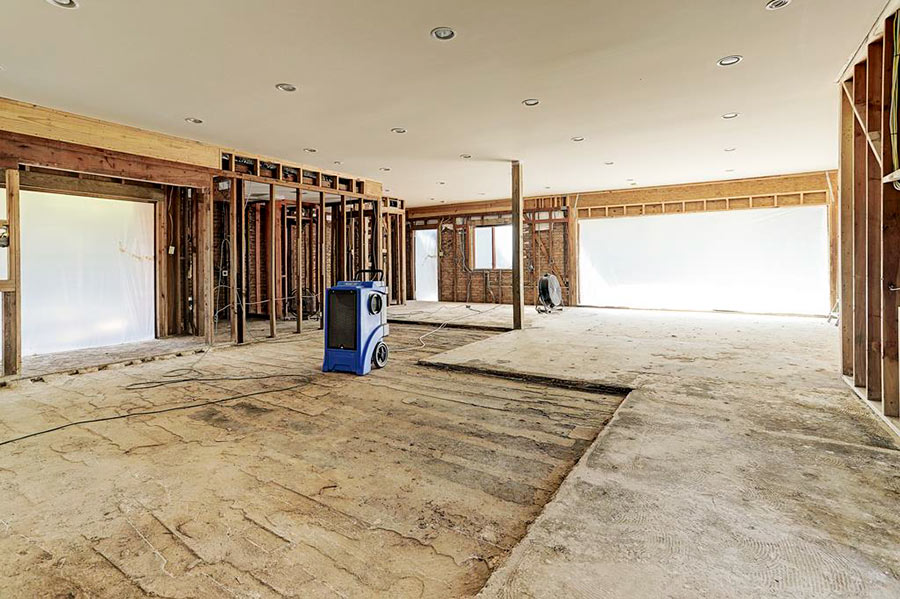
- 17 Legend Ln. [HAR]
COMMENT OF THE DAY: A QUICKER END TO MEMORIAL BEND’S MOD ERA  “The Memorial Bend neighborhood (which includes the featured Faust Lane home) was impacted hard by Harvey. It has/had some of the best collections of mid-century modern homes in Houston. Due to escalating land values, their numbers were already dwindling annually before the storm and I’m afraid this will only reduce their numbers faster. At least, we’ll have historic Google street view as a reference.” [Native Houstonian, commenting on Daily Demolition Report: The Faust and the Furious] Photo of 442 Faust Ln.: Griffin Vance
“The Memorial Bend neighborhood (which includes the featured Faust Lane home) was impacted hard by Harvey. It has/had some of the best collections of mid-century modern homes in Houston. Due to escalating land values, their numbers were already dwindling annually before the storm and I’m afraid this will only reduce their numbers faster. At least, we’ll have historic Google street view as a reference.” [Native Houstonian, commenting on Daily Demolition Report: The Faust and the Furious] Photo of 442 Faust Ln.: Griffin Vance
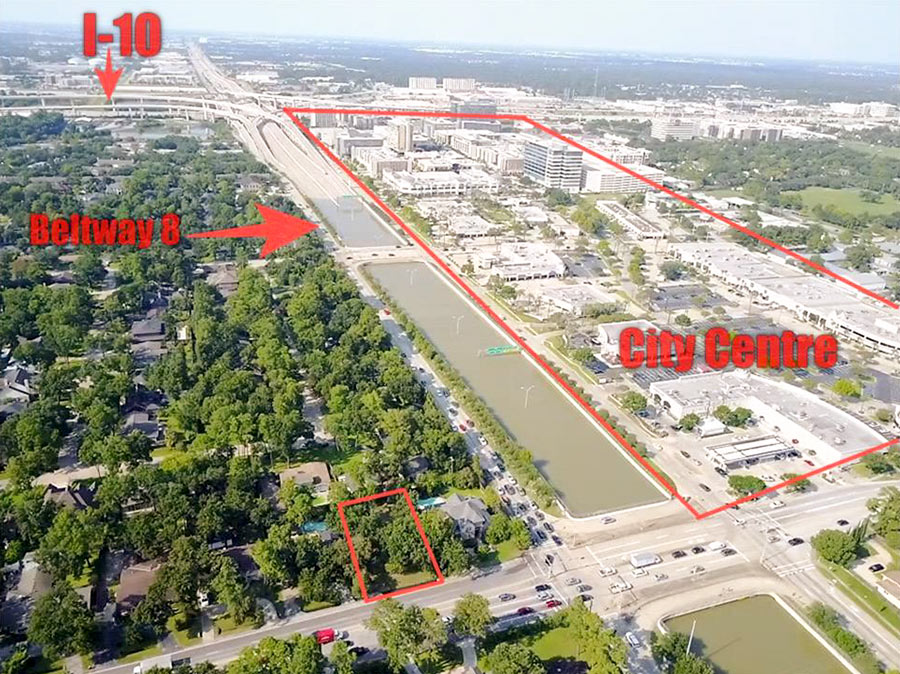
That’s not a retention pond pictured near the center of these aerial shots highlighting the vacant lot at 12906 Memorial Dr. — or at least that wasn’t its original main purpose: It’s the Sam Houston Tollway, shown filled almost to the brim after Hurricane Harvey flooding. “Lot has been cleared and is ready for construction,” declares the listing description for the featured 11,760-sq.-ft. vacant property, one house away from the corner of Memorial and Beltway 8. It’s now marked down to $505,000.
The only photos of the lot included in the listing are drone views that include the adjacent Memorial Dr. underpass, shown in its full-of-water configuration:
COMMENT OF THE DAY: A WATERSHED APPROACH TO PAYING FOR FLOOD CONTROL  “. . . I think that if we are going to be realistic about the way that we finance flood control, that the core of such a plan needs to take a page from how flood insurance gets underwritten. Everybody pays a property tax to a watershed-specific flood control entity, but that tax is adjusted based on the elevation of their first-floor living area relative to the Base Flood Elevation. If you’re more than a few feet above it, your tax is very low. If you live more than a few feet below it . . . you’re probably going to pay so much in taxes that it’ll become immediately economic to raise your structure or demolish it. Right away, the inventory and value of property subject to flood risk is reduced; and what’s left that is tolerably at-risk pays for its own reduced need for risk mitigation. And . . . if we’re too gun shy to pull the trigger on a plan like this, which would totally wipe out a lot of people’s equity in vast swaths of real estate, okay well that’s where people not at very much risk should be expected to pay more taxes even without receiving very much in the way of benefits. Yeah, I’m basically proposing Obamacare for flood control in Houston, but only as a humane alternative which reveals a startling truth: that the big money for this sort of thing is unlikely to come from up on high, from the feds or the state government (and it shouldn’t IMO). Financing this stuff locally is going to hurt. One thing is very very clear: whatever kinds of administrative bodies are created or re-jiggered to deal with this issue have got to address legacy development first and foremost. We need a plan to cope with what is already on the ground. This is not something that we can just build ourselves out of, going forward, with stricter rules for new development, feel the catharsis, hold hands and sing Kumbaya, and call it a day.” [TheNiche, commenting on An 8th Wonder Distillery; New Bridges for Brays Bayou; How Apartment Buildings Get On Your Nerves]
“. . . I think that if we are going to be realistic about the way that we finance flood control, that the core of such a plan needs to take a page from how flood insurance gets underwritten. Everybody pays a property tax to a watershed-specific flood control entity, but that tax is adjusted based on the elevation of their first-floor living area relative to the Base Flood Elevation. If you’re more than a few feet above it, your tax is very low. If you live more than a few feet below it . . . you’re probably going to pay so much in taxes that it’ll become immediately economic to raise your structure or demolish it. Right away, the inventory and value of property subject to flood risk is reduced; and what’s left that is tolerably at-risk pays for its own reduced need for risk mitigation. And . . . if we’re too gun shy to pull the trigger on a plan like this, which would totally wipe out a lot of people’s equity in vast swaths of real estate, okay well that’s where people not at very much risk should be expected to pay more taxes even without receiving very much in the way of benefits. Yeah, I’m basically proposing Obamacare for flood control in Houston, but only as a humane alternative which reveals a startling truth: that the big money for this sort of thing is unlikely to come from up on high, from the feds or the state government (and it shouldn’t IMO). Financing this stuff locally is going to hurt. One thing is very very clear: whatever kinds of administrative bodies are created or re-jiggered to deal with this issue have got to address legacy development first and foremost. We need a plan to cope with what is already on the ground. This is not something that we can just build ourselves out of, going forward, with stricter rules for new development, feel the catharsis, hold hands and sing Kumbaya, and call it a day.” [TheNiche, commenting on An 8th Wonder Distillery; New Bridges for Brays Bayou; How Apartment Buildings Get On Your Nerves]
ADDICKS AND BARKER RESERVOIRS ARE NOW COMPLETELY EMPTY AND READY FOR THE NEXT FLOOD 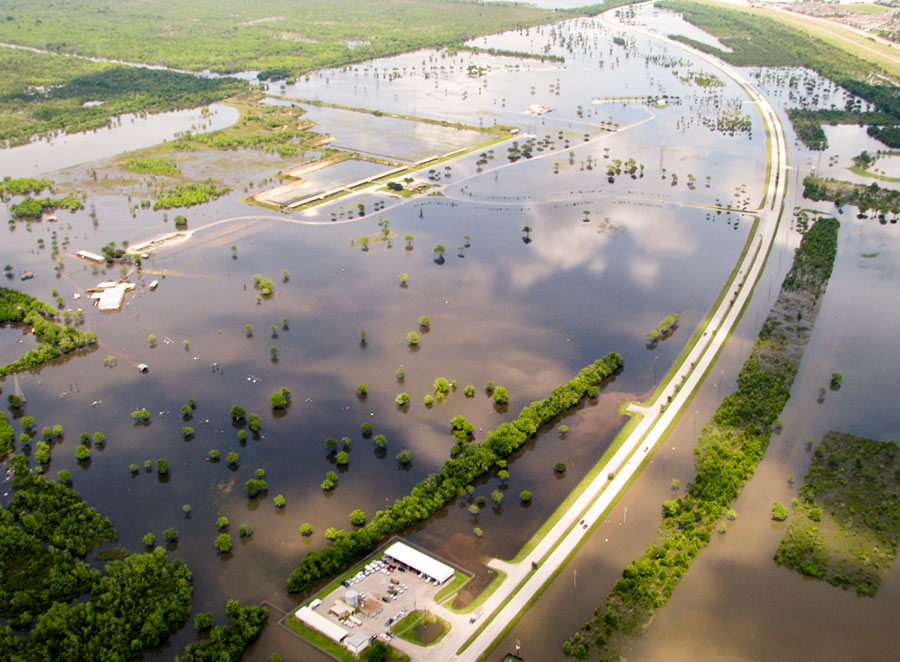 All water stuck behind the Addicks and Barker dams has now been released, the Army Corps of Engineers announced late yesterday. That means that for the first time since Hurricane Harvey-triggered rains began filling the 24,520-acre reservoirs, they are now dry and available for use again as parkland. The last bits of water actually left the Addicks and Barker reservoirs last Thursday, October 12th, and Friday the 13th respectively; the announcement was delayed, a public-affairs officer tells reporter Amelia Brust, in order to “receive legal guidance.” The Corps, writes Brust, “is now a defendant in multiple lawsuits brought by surrounding property owners who say their homes and businesses were flooded as a result of the dams’ releases.” [Community Impact] Photo of American Shooting Centers and Millie Bush Dog Park off Westheimer Pkwy. in Barker Reservoir, flooded after Memorial Day, 2015: U.S. Army Corps of Engineers [license]
All water stuck behind the Addicks and Barker dams has now been released, the Army Corps of Engineers announced late yesterday. That means that for the first time since Hurricane Harvey-triggered rains began filling the 24,520-acre reservoirs, they are now dry and available for use again as parkland. The last bits of water actually left the Addicks and Barker reservoirs last Thursday, October 12th, and Friday the 13th respectively; the announcement was delayed, a public-affairs officer tells reporter Amelia Brust, in order to “receive legal guidance.” The Corps, writes Brust, “is now a defendant in multiple lawsuits brought by surrounding property owners who say their homes and businesses were flooded as a result of the dams’ releases.” [Community Impact] Photo of American Shooting Centers and Millie Bush Dog Park off Westheimer Pkwy. in Barker Reservoir, flooded after Memorial Day, 2015: U.S. Army Corps of Engineers [license]
COMMENT OF THE DAY: WHAT YOU’RE SEEING AND SMELLING IN FLOODED APARTMENTS  “I have a question regarding the apartments in Kingwood. There is a statement in the letter from the apartments indicating that there is a clear difference between mold and mildew. I understand it as they are both one and the same when it comes to interior livable spaces. If it smells and-or is visible you have a problem irregardless of the classification of mold or mildew.
Is this not correct? Is there a legal distinction per Texas Law? Can someone please chime in? Thanks.” [It Smells, commenting on The City That Will Be Building and Rebuilding Forever; Houston’s Long Amazon Odds; The Latest Poke Place] Illustration: Lulu
“I have a question regarding the apartments in Kingwood. There is a statement in the letter from the apartments indicating that there is a clear difference between mold and mildew. I understand it as they are both one and the same when it comes to interior livable spaces. If it smells and-or is visible you have a problem irregardless of the classification of mold or mildew.
Is this not correct? Is there a legal distinction per Texas Law? Can someone please chime in? Thanks.” [It Smells, commenting on The City That Will Be Building and Rebuilding Forever; Houston’s Long Amazon Odds; The Latest Poke Place] Illustration: Lulu
SURVEYING THE SOGGY AFTERMATH OF HOUSTON’S ULTIMATE HOME-TOUR TEST 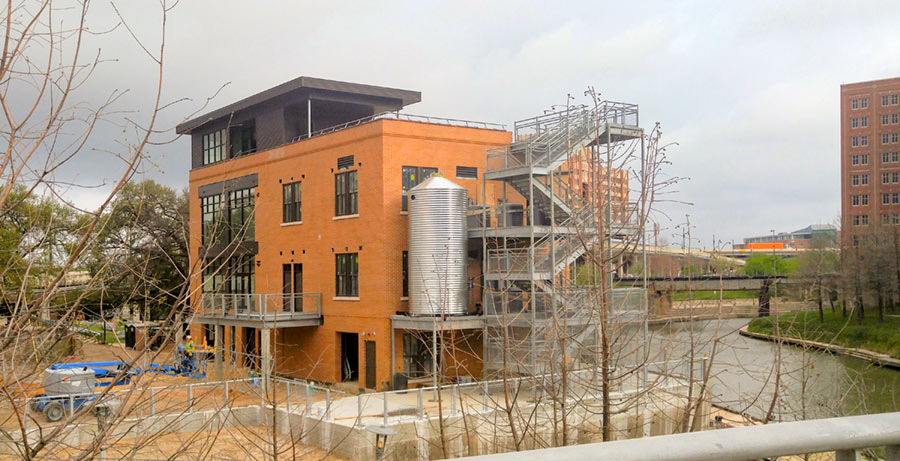 Talk about timing: The Rice Design Alliance’s annual home tour this past March opened to inspection 6 structures built in Houston floodplains with some sort of strategy to make it through a major water event. How’d these properties survive the cataclysm that followed only 5 months later? A 1965 Meyerland home on the tour by Houston architects Brooks and Brooks one block north of Brays Bayou was damaged, Jack Murphy reports. And his follow-up story on the RDA’s H2Ouston tour includes no word on the Harvey experiences of François de Menil’s 5-story Temple Terrace townhome or the 3-story butterfly-roof home on Logan Ln. backing up to Buffalo Bayou Taft Architects built in 1996. But 2 more recently built homes on the tour — 2-story structures by architects Brett Zamore in Linkwood and Nonya Grenader in Shirkmere survived without much more than messes in their garages (and a flooded-out car), according to Murphy. Then there’s the Sunset Coffee Building fronting Buffalo Bayou Downtown, which serves as the offices of the Buffalo Bayou Partnership, and which in its recent redo by Lake Flato and BNIM (pictured), was designed to take on water: “All sources indicate that the design performed as anticipated. . . . The staff moved exhibit materials to the second floor and secured the elevator on an upper floor. But there are always issues. The grease trap filled with water, thermostats need to be replaced, and the elevator shaft had five feet of standing water at the bottom, causing electrical issues. Security cameras mounted on the building filled with water and malfunctioned. The fire alarm went off for four days, making the area sound like a war zone, even catching the attention of a CNN reporter. Still, water didn’t crest into the offices on the second floor. (It was almost this high during Allison.) Shortly after the waters receded, the building was habitable again.” But this sort of resilience wasn’t just added to the building by its renovators: “The BBP’s Rebecca Leija and Anne Olson told me their insurance adjuster said the Sunset Building, built in 1910, was well-suited to handle floods due to its height and angle relative to the bayou. Sure enough, in plan the building is set at an angle to the bayou’s flow, presenting a corner to floodwaters rather than a flat face. And, its east façade breaks slightly, perhaps to further reduce the surface area ‘seen’ by floodwaters and therefore reduce their force on the walls and foundation.” [OffCite] Photo of Sunset Coffee Building renovation: Adam Williams
Talk about timing: The Rice Design Alliance’s annual home tour this past March opened to inspection 6 structures built in Houston floodplains with some sort of strategy to make it through a major water event. How’d these properties survive the cataclysm that followed only 5 months later? A 1965 Meyerland home on the tour by Houston architects Brooks and Brooks one block north of Brays Bayou was damaged, Jack Murphy reports. And his follow-up story on the RDA’s H2Ouston tour includes no word on the Harvey experiences of François de Menil’s 5-story Temple Terrace townhome or the 3-story butterfly-roof home on Logan Ln. backing up to Buffalo Bayou Taft Architects built in 1996. But 2 more recently built homes on the tour — 2-story structures by architects Brett Zamore in Linkwood and Nonya Grenader in Shirkmere survived without much more than messes in their garages (and a flooded-out car), according to Murphy. Then there’s the Sunset Coffee Building fronting Buffalo Bayou Downtown, which serves as the offices of the Buffalo Bayou Partnership, and which in its recent redo by Lake Flato and BNIM (pictured), was designed to take on water: “All sources indicate that the design performed as anticipated. . . . The staff moved exhibit materials to the second floor and secured the elevator on an upper floor. But there are always issues. The grease trap filled with water, thermostats need to be replaced, and the elevator shaft had five feet of standing water at the bottom, causing electrical issues. Security cameras mounted on the building filled with water and malfunctioned. The fire alarm went off for four days, making the area sound like a war zone, even catching the attention of a CNN reporter. Still, water didn’t crest into the offices on the second floor. (It was almost this high during Allison.) Shortly after the waters receded, the building was habitable again.” But this sort of resilience wasn’t just added to the building by its renovators: “The BBP’s Rebecca Leija and Anne Olson told me their insurance adjuster said the Sunset Building, built in 1910, was well-suited to handle floods due to its height and angle relative to the bayou. Sure enough, in plan the building is set at an angle to the bayou’s flow, presenting a corner to floodwaters rather than a flat face. And, its east façade breaks slightly, perhaps to further reduce the surface area ‘seen’ by floodwaters and therefore reduce their force on the walls and foundation.” [OffCite] Photo of Sunset Coffee Building renovation: Adam Williams
WHAT MAKES WEST HOUSTON THE BERMUDA TRIANGLE OF REAL ESTATE DISCLOSURE 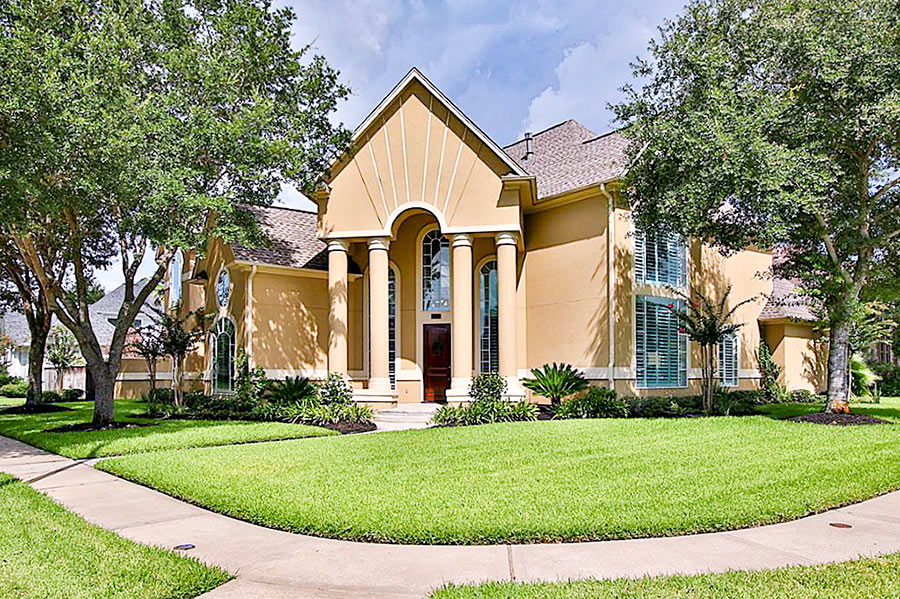 “None of the more than half a dozen residents interviewed by The Texas Tribune and ProPublica after the floods said they knew they were living inside Addicks or Barker — many of their neighborhoods are several miles away from the dams. Several local officials — including Houston’s ‘flood czar’ and a neighboring county executive — said they had no idea the neighborhoods had been built inside the flood pools. Several real estate agents said they didn’t realize they were selling homes inside the pools.” This from the latest exposé on how 14,000 homes came to be located in designed-to-flood areas inside the Addicks and Barker reservoirs. First, the good news: Of those 14,000 homes, only 5,138 of them flooded this time! Among the many additional OMG-worthy revelations from this latest report from the crack Houston-flooding investigations team of Neena Satija, Kiah Collier, and Al Shaw: Of those homes built inside the reservoirs, at least 4,000 of them were built after Tropical Storm Allison hit in 2001. That’s interesting to note, considering that a Harris County Flood Control District report published in 2003 warned that as many as 2,000 acres of private land inside the reservoirs might easily have flooded in that storm if the rains had fallen in a slightly different location. Also included: this little glance at the area’s real-estate future: “One five-bedroom home in Lakes on Eldridge . . . was listed for $678,000 about two weeks before it flooded during Harvey. The seller’s agent, Moira Holden, tried to put a positive spin on things when she updated the online listing that decreased the asking price by $10,000. ‘Unfortunately this stunning home did flood and is being refurbished to the highest spec!’ it says. ‘Fabulous chance to choose your finishes!‘ When asked if she would disclose to potential buyers that the home was inside Addicks Reservoir, Holden didn’t have a clear answer. ‘I will obviously disclose whatever we are required to disclose,’ she said, pointing out that the home wasn’t in a floodplain. ‘I would hope that the buyer’s Realtor would do their due diligence on that.'” [Texas Tribune; previously on Swamplot] Photo of 13119 Shermons Pond, for sale in Lakes on Eldridge: HAR
“None of the more than half a dozen residents interviewed by The Texas Tribune and ProPublica after the floods said they knew they were living inside Addicks or Barker — many of their neighborhoods are several miles away from the dams. Several local officials — including Houston’s ‘flood czar’ and a neighboring county executive — said they had no idea the neighborhoods had been built inside the flood pools. Several real estate agents said they didn’t realize they were selling homes inside the pools.” This from the latest exposé on how 14,000 homes came to be located in designed-to-flood areas inside the Addicks and Barker reservoirs. First, the good news: Of those 14,000 homes, only 5,138 of them flooded this time! Among the many additional OMG-worthy revelations from this latest report from the crack Houston-flooding investigations team of Neena Satija, Kiah Collier, and Al Shaw: Of those homes built inside the reservoirs, at least 4,000 of them were built after Tropical Storm Allison hit in 2001. That’s interesting to note, considering that a Harris County Flood Control District report published in 2003 warned that as many as 2,000 acres of private land inside the reservoirs might easily have flooded in that storm if the rains had fallen in a slightly different location. Also included: this little glance at the area’s real-estate future: “One five-bedroom home in Lakes on Eldridge . . . was listed for $678,000 about two weeks before it flooded during Harvey. The seller’s agent, Moira Holden, tried to put a positive spin on things when she updated the online listing that decreased the asking price by $10,000. ‘Unfortunately this stunning home did flood and is being refurbished to the highest spec!’ it says. ‘Fabulous chance to choose your finishes!‘ When asked if she would disclose to potential buyers that the home was inside Addicks Reservoir, Holden didn’t have a clear answer. ‘I will obviously disclose whatever we are required to disclose,’ she said, pointing out that the home wasn’t in a floodplain. ‘I would hope that the buyer’s Realtor would do their due diligence on that.'” [Texas Tribune; previously on Swamplot] Photo of 13119 Shermons Pond, for sale in Lakes on Eldridge: HAR
COMMENT OF THE DAY: A BETTER IDEA FOR WHAT TO DO WITH THE SPACES UNDER FREEWAYS IN HOUSTON  “. . . This gave me an idea. That land under freeways isn’t good for retail or anything inhabited. But it could be a perfect place to dig down and create auxiliary stormwater detention facilities.
Yeah the water will be filthy, like your friends bikes usually are, but floodwater usually is. And as auxiliary detention they would only be used in extreme rainfall events (once or twice a year during so-called ‘hundred year’ storms).” [ZAW, commenting on Comment of the Day Second Runner-Up: Things To Think About Before You Start Planning Under-Freeway Developments] Illustration: Lulu
“. . . This gave me an idea. That land under freeways isn’t good for retail or anything inhabited. But it could be a perfect place to dig down and create auxiliary stormwater detention facilities.
Yeah the water will be filthy, like your friends bikes usually are, but floodwater usually is. And as auxiliary detention they would only be used in extreme rainfall events (once or twice a year during so-called ‘hundred year’ storms).” [ZAW, commenting on Comment of the Day Second Runner-Up: Things To Think About Before You Start Planning Under-Freeway Developments] Illustration: Lulu
HOUSING AUTHORITY: OUR FLOODED CLAYTON HOMES DEVELOPMENT WAS GOING TO BE DEMOLISHED ANYWAY 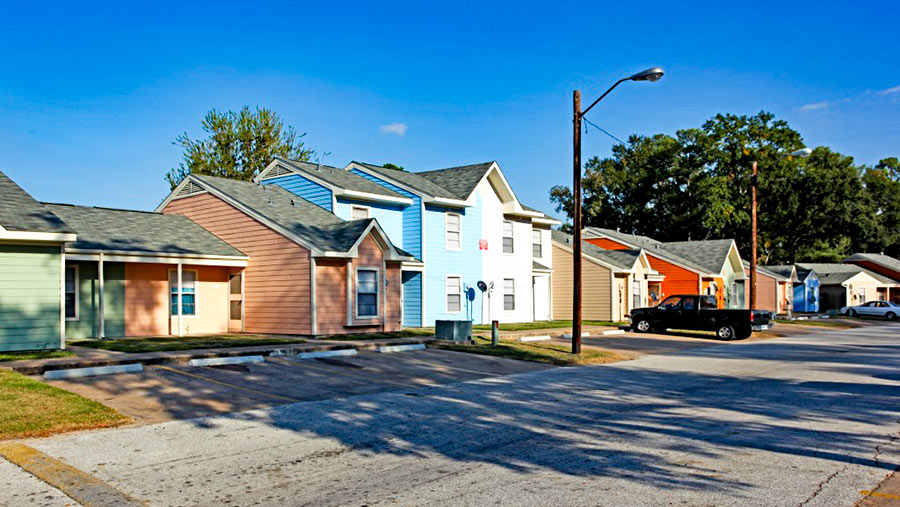 A new statement from the Houston Housing Authority provides a little more background on its decision to demolish 112 of the 296 units at the authority’s Clayton Homes low-income housing neighborhood just east of Hwy 59 at the northern tip of EaDo. The homes were deemed “uninhabitable” after flooding from Hurricane Harvey triggered mold and other health concerns: “HHA decided demolition was the best course of action for the damaged units since the entire property is located on land acquired by eminent domain and will face eventual demolition for TxDOT’s I-45 freeway extension. When the remainder of Clayton units are demolished in a few years, the remaining residents will either be relocated to another public housing unit or receive HCVs.” Housing Choice (formerly Section 8) Vouchers — along with moving assistance and payments — are also being provided to residents of 82 out of the 100 units at another Housing Authority development, Forest Green Townhomes at 8945 Forest Hollow St. in northeast Houston, which the authority today announced had also been rendered unlivable by the storm. [Houston Housing Authority; previously on Swamplot] Photo of pre-Harvey Forest Green Townhomes: Forest Green
A new statement from the Houston Housing Authority provides a little more background on its decision to demolish 112 of the 296 units at the authority’s Clayton Homes low-income housing neighborhood just east of Hwy 59 at the northern tip of EaDo. The homes were deemed “uninhabitable” after flooding from Hurricane Harvey triggered mold and other health concerns: “HHA decided demolition was the best course of action for the damaged units since the entire property is located on land acquired by eminent domain and will face eventual demolition for TxDOT’s I-45 freeway extension. When the remainder of Clayton units are demolished in a few years, the remaining residents will either be relocated to another public housing unit or receive HCVs.” Housing Choice (formerly Section 8) Vouchers — along with moving assistance and payments — are also being provided to residents of 82 out of the 100 units at another Housing Authority development, Forest Green Townhomes at 8945 Forest Hollow St. in northeast Houston, which the authority today announced had also been rendered unlivable by the storm. [Houston Housing Authority; previously on Swamplot] Photo of pre-Harvey Forest Green Townhomes: Forest Green
COMMENT OF THE DAY: DON’T SAY I DIDN’T WARN YOU ABOUT THE WHOLE MOLD BUSINESS  “So for homeowners you just cut the sheetrock, and rebuild all of the stuff at 3 feet and go down the road? My feeling is that every house that flooded has some trace of E. Coli and mold. Pretty soon you’ll see mold lawyer commercials suing every contractor that worked in these places. Doctors will soon get in on the action too. Hell, back in 2000 when mold lawsuits were born my framer had a magnetic door sign for ‘mold testing and remediation’ in the back seat of his pick-up. Get ready for it again.” [Sporey McGee, commenting on Housing Authority Ready To Demolish More Than a Third of Clayton Homes After Harvey Flooding] Illustration: Lulu
“So for homeowners you just cut the sheetrock, and rebuild all of the stuff at 3 feet and go down the road? My feeling is that every house that flooded has some trace of E. Coli and mold. Pretty soon you’ll see mold lawyer commercials suing every contractor that worked in these places. Doctors will soon get in on the action too. Hell, back in 2000 when mold lawsuits were born my framer had a magnetic door sign for ‘mold testing and remediation’ in the back seat of his pick-up. Get ready for it again.” [Sporey McGee, commenting on Housing Authority Ready To Demolish More Than a Third of Clayton Homes After Harvey Flooding] Illustration: Lulu
THE HEIGHTS HISTORIC DISTRICTS’ NEW HEIGHTS 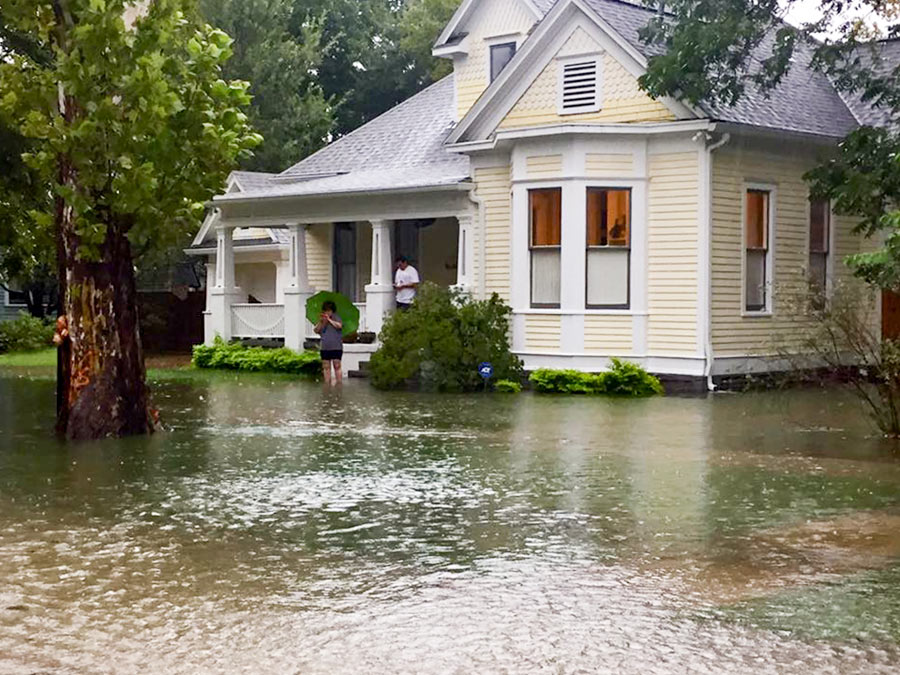 The public comment period for the latest (and presumably final) draft of the design guidelines for the Houston Heights’s 3 historic districts ends today. The latest version of the 223-page document dates from August and covers a range of issues important to the historic districts, including proposed standards for construction and renovation — from roof pitches and “character defining elements” to maximum allowable foundation height (30 inches from natural elevation for new construction and additions) — but does not appear to include any mention of flooding. The guidelines, once adopted, would be used by the Houston Archeological and Historical Commission in its determinations of what proposed building projects would be allowed. [Planning & Development Dept.; previously on Swamplot] Photo of home at 8th St. and Arlington St., in Houston Heights Historic District South, during Harvey: Swamplot inbox
The public comment period for the latest (and presumably final) draft of the design guidelines for the Houston Heights’s 3 historic districts ends today. The latest version of the 223-page document dates from August and covers a range of issues important to the historic districts, including proposed standards for construction and renovation — from roof pitches and “character defining elements” to maximum allowable foundation height (30 inches from natural elevation for new construction and additions) — but does not appear to include any mention of flooding. The guidelines, once adopted, would be used by the Houston Archeological and Historical Commission in its determinations of what proposed building projects would be allowed. [Planning & Development Dept.; previously on Swamplot] Photo of home at 8th St. and Arlington St., in Houston Heights Historic District South, during Harvey: Swamplot inbox
HOUSING AUTHORITY READY TO DEMOLISH MORE THAN A THIRD OF CLAYTON HOMES AFTER HARVEY FLOODING 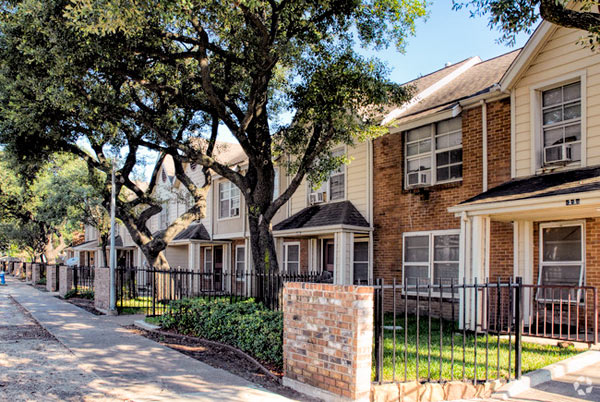 112 of the 296 apartments at Clayton Homes have been deemed “uninhabitable” by its owner, the Houston Housing Authority, which is now seeking to demolish them. The affordable-housing complex tucked between Hwy. 59 and Buffalo Bayou north of Runnels St. in the northwest corner of the East End was flooded after Hurricane Harvey; subsequent investigations conducted by local researchers led by the New York Times and by the authority found numerous health and safety problems in the residences, including festering mold and high levels of E. coli. Submitting a demolition request for those units allowed the authority to receive and distribute “tenant protection vouchers” that will allow their residents to relocate to any voucher-accepting unit in the city, a spokesperson for the agency says: “Since Hurricane Harvey caused extensive damage to many of HHA’s public housing properties, housing options within HHA’s public housing program are now exhausted, which is why residents are receiving vouchers.” The agency says it is also helping Clayton Homes residents not eligible for the vouchers as well to find new homes — with relocation assistance services and one-time payments — and that it is refunding rents collected for periods when homes in the complex were uninhabitable. Photo: Apartments.com
112 of the 296 apartments at Clayton Homes have been deemed “uninhabitable” by its owner, the Houston Housing Authority, which is now seeking to demolish them. The affordable-housing complex tucked between Hwy. 59 and Buffalo Bayou north of Runnels St. in the northwest corner of the East End was flooded after Hurricane Harvey; subsequent investigations conducted by local researchers led by the New York Times and by the authority found numerous health and safety problems in the residences, including festering mold and high levels of E. coli. Submitting a demolition request for those units allowed the authority to receive and distribute “tenant protection vouchers” that will allow their residents to relocate to any voucher-accepting unit in the city, a spokesperson for the agency says: “Since Hurricane Harvey caused extensive damage to many of HHA’s public housing properties, housing options within HHA’s public housing program are now exhausted, which is why residents are receiving vouchers.” The agency says it is also helping Clayton Homes residents not eligible for the vouchers as well to find new homes — with relocation assistance services and one-time payments — and that it is refunding rents collected for periods when homes in the complex were uninhabitable. Photo: Apartments.com
ALL THE DAMS AND MAGIC WETLANDS CAN DO  Big, fat, cleared floodplains are the best way to handle a very large storm, explains wetlands scientist John Jacob — because nothing else is going to: “An average rainfall of 35 inches over all of Harris County (Harvey) is just over 1 trillion gallons. At most, there are about 50 billion gallons of stormwater detention capacity in Harris County wetlands (no one has measured this — I had to make some very broad assumptions). So that means that the wetlands at best could handle about 5% of the total volume of Harvey rainfall. In the large scheme of things, it’s not much. And the scheme of things in Harvey is indeed very large.
So much for the magic wetlands. But what about our engineered drainage system? I calculate a somewhat larger detention capacity — between our large US Army Corps of Engineers Katy Prairie reservoirs (~400,000 acre-ft) and Harris County Flood Control District detention (about 34,000 acre-feet), we have about 130 billion gallons of detention volume. More than what we have for wetlands, but still only about 14% of Harvey. As we painfully saw, also overwhelmed.
And what of green stormwater infrastructure — rain gardens, bioswales, green roofs, etc.? We don’t have any good numbers here, but you can be sure that even if these practices were widespread, the volume would be very small relative to wetlands and detention basins. These practices are designed to capture at best a 2 inch storm.” [Watershed Texas] Photo of Willow Waterhole Greenspace: Luz (license)
Big, fat, cleared floodplains are the best way to handle a very large storm, explains wetlands scientist John Jacob — because nothing else is going to: “An average rainfall of 35 inches over all of Harris County (Harvey) is just over 1 trillion gallons. At most, there are about 50 billion gallons of stormwater detention capacity in Harris County wetlands (no one has measured this — I had to make some very broad assumptions). So that means that the wetlands at best could handle about 5% of the total volume of Harvey rainfall. In the large scheme of things, it’s not much. And the scheme of things in Harvey is indeed very large.
So much for the magic wetlands. But what about our engineered drainage system? I calculate a somewhat larger detention capacity — between our large US Army Corps of Engineers Katy Prairie reservoirs (~400,000 acre-ft) and Harris County Flood Control District detention (about 34,000 acre-feet), we have about 130 billion gallons of detention volume. More than what we have for wetlands, but still only about 14% of Harvey. As we painfully saw, also overwhelmed.
And what of green stormwater infrastructure — rain gardens, bioswales, green roofs, etc.? We don’t have any good numbers here, but you can be sure that even if these practices were widespread, the volume would be very small relative to wetlands and detention basins. These practices are designed to capture at best a 2 inch storm.” [Watershed Texas] Photo of Willow Waterhole Greenspace: Luz (license)

